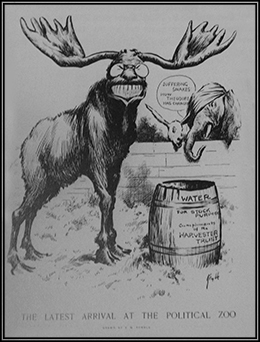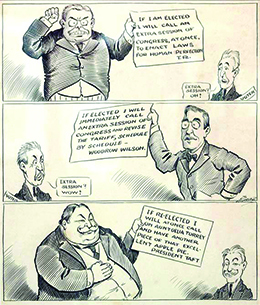| << Chapter < Page | Chapter >> Page > |
Although not as flamboyant or outwardly progressive as Roosevelt, Taft’s organizational skills and generally solid performance as president aligned with the party leadership’s concerns over another Roosevelt presidency and secured for him the Republican Party’s nomination. Angry over this snub, in 1912, Roosevelt and the other Progressive Republicans bolted the Republican Party and formed the Progressive Party . His popularity had him hoping to win the presidential race as a third-party candidate. When he survived an assassination attempt in Milwaukee, Wisconsin, in October 1912—the assassin’s bullet hit his eyeglass case and only injured him superficially—he turned the near-death experience into a political opportunity. Insisting upon delivering the speech before seeking medical attention, he told the crowd, “It takes more than a bullet to kill a bull moose!” The moniker stuck, and Roosevelt’s Progressive Party would be known as the Bull Moose Party for the remainder of the campaign ( [link] ).

The Democrats realized that a split Republican Party gave them a good chance of regaining the White House for the first time since 1896. They found their candidate in the Progressive governor of New Jersey, Woodrow Wilson. A former history professor and president at Princeton University, Wilson had an academic demeanor that appealed to many Progressive reformers. Many Democrats also viewed Wilson as a Washington outsider who had made far fewer political enemies than Roosevelt and Taft.
Taft never truly campaigned for the post, did not deliver a single speech, and did not seem like a serious contender. In their campaigns, Roosevelt and Wilson formulated competing Progressive platforms. Wilson described his more moderate approach as one of New Freedom , which stood for a smaller federal government to protect public interests from the evils associated with big businesses and banks. Roosevelt campaigned on the promise of New Nationalism , a charge that he said required a vigorous and powerful federal government to protect public interests. He sought to capitalize on the stewardship approach that he had made famous during his previous administration.
Wilson won the 1912 election with over six million votes, with four million votes going to Roosevelt and three and one-half million for Taft. The internal split among Republicans not only cost them the White House but control of the Senate as well—and Democrats had already won a House majority in 1910. Wilson won the presidency with just 42 percent of the popular vote, which meant that he would have to sway a large number of voters should he have any aspirations for a second term.
In his 2002 article on the 1912 election, historian Sidney M. Milkis writes,
The Progressive Party’s “compromise” with public opinion in the United States points to its legacy for American politics and government. Arguably, the failure of the 1912 experiment and the Progressive Party’s demise underscore the incoherence of the Progressive movement. Nevertheless, it was neither the Democrats, nor the Republicans, nor the Socialists who set the tone of the 1912 campaign. It was the Progressives. Beyond the 1912 election, their program of political and social reform has been an enduring feature of American political discourse and electoral struggle. The Progressive Party forged a path of reform that left both social democracy and conservatism—Taft’s constitutional sobriety—behind. Similarly, T.R.’s celebrity, and the popularity of the Progressive doctrine of the people’s right to rule, tended to subordinate the more populist to the more plebiscitary schemes in the platform, such as the initiative, the referendum, and the direct primary, which exalted not the “grass roots” but mass opinion. Indeed, in the wake of the excitement aroused by the Progressive Party, Wilson, whose New Freedom campaign was far more sympathetic to the decentralized state of courts and parties than T.R.’s, felt compelled, as president, to govern as a New Nationalist Progressive.
It is interesting to think of how this most unusual election—one with three major candidates that pitted a former president against an incumbent and a major party contender—related to the larger Progressive movement. The cartoon below is only one of many cartoons of that era that sought to point out the differences between the candidates ( [link] ). While Roosevelt and the Progressive Party ultimately lost the election, they required the dialogue of the campaign to remain on the goals of Progressivism, particularly around more direct democracy and business regulation. The American public responded with fervor to Roosevelt’s campaign, partly because of his immense popularity, but partly also because he espoused a kind of direct democracy that gave people a voice in federal politics. Although Wilson and his New Freedom platform won the election, his presidency undertook a more activist role than his campaign suggested. The American public had made clear that, no matter who sat in the White House, they were seeking a more progressive America.


Notification Switch
Would you like to follow the 'U.s. history' conversation and receive update notifications?